Quick Answer
This Tom Saap recipe is an authentic Thai hot and sour pork rib soup featuring tender meat, aromatic herbs, and a perfect balance of spicy, sour, and savory flavors. The secret to its distinctive taste lies in the combination of galangal, lemongrass, kaffir lime leaves, and fresh lime juice. This northeastern Thai specialty takes only 30 minutes of active cooking time.
Pin this authentic Thai recipe for later!

Mastering Tom Saap Recipe (Thai Pork Rib Soup)
Ingredients
- 2 lbs pork ribs cut into bite-sized pieces
- 8 cups water
- 1 stalk lemongrass cut into 2-inch pieces and bruised
- 4 kaffir lime leaves
- 1 inch piece galangal sliced
- 5 cloves garlic crushed
- 2 shallots sliced
- 3-4 Thai bird's eye chilies crushed
- 2 tablespoon fish sauce
- 1` tablespoon lime juice
- 1 teaspoon sugar
- 1 cup mushrooms sliced
- Fresh cilantro chopped (for garnish)
- Green onions chopped (for garnish)
- Fresh lime wedges for serving
Instructions
- Prepar your ingredients:Begin by preparing all your ingredients. Cut the pork ribs into bite-sized pieces and set aside. Bruise the lemongrass by lightly smashing it with the back of a knife to release its flavors. Tear the kaffir lime leaves to enhance their fragrance. Slice the galangal, crush the garlic, and slice the shallots. These aromatic ingredients will form the flavor base of your soup.
- Boil the Pork RibsIn a large pot, bring the 8 cups of water to a boil. Add the pork ribs and let them boil for 5 minutes. This step helps to remove any impurities from the meat, ensuring a clean and clear broth. After boiling, drain and rinse the ribs under cold water to eliminate any remaining impurities after boiling.
- Simmer with AromaticsReturn the cleaned ribs to the pot and add the bruised lemongrass, torn kaffir lime leaves, sliced galangal, crushed garlic, and sliced shallots. Pour in the water and bring to a gentle boil. Reduce the heat to low and let the soup simmer for about 1.5 to 2 hours. This slow simmering allows the flavors to meld together and the pork ribs to become tender.
- Add Mushrooms and SeasonAfter simmering:Add the sliced mushrooms to the pot and cook for 10 minutes.Season the soup with fish sauce, lime juice, and sugar. Stir well to combine, and taste to adjust the seasoning as needed. The salty, sour, and slightly sweet balance should be just right, enhancing the soup's natural flavors.
- Garnish and ServeLadle the soup into bowls and garnish with fresh cilantro, green onions and Thai-bird chili's. Serve with fresh lime wedges on the side for an extra burst of citrus flavor. Enjoy your homemade Thai Pork Ribs Soup hot, and savor the aromatic and flavorful broth.
Video
Authentic Tom Saap Recipe: Thai Hot and Sour Pork Rib Soup

Notes
Nutrition
What's in this Tom Saap Recipe post

Why You'll Love This Recipe
Visual Walk-Through
Common Mistakes to Avoid
Flavor Profile
Frequently Asked Questions
More Thai Recipes You'll Love
Recipe Notes and Tips

Why You'll Love This Moo Krob Recipe
Sawasdee Kha, and Hello
This Tom Saap recipe (Pork Rib Soup) stands apart from westernized versions by honoring traditional Isan (northeastern Thai) techniques my grandmother practiced for decades. The combination of tender pork ribs and the aromatic herbs creates a dining experience that transports you directly to the countryside of Thailand, where this soup originates.
After testing this recipe 8 times while developing my coming cookbook I discovered that bruising the lemongrass and tearing the kaffir lime leaves (rather than just adding them whole) releases significantly more essential oils, creating that authentic aroma that filled my childhood kitchen every Sunday morning.
You'll appreciate how the flavors develop complexity while remaining true to the rustic, straightforward nature of Thai countryside cooking—a tradition my family has maintained for generations. The balance of spicy bird's eye chilies against the bright citrus notes creates an addictive combination that makes this soup impossible to forget.
Share this authentic Thai recipe with your friends who appreciate bold flavors!
Share this recipe with friends who love authentic Thai flavors!

Visual Guide to Tom Saap Recipe
To create an authentic Tom Saap recipe (Pork Rib Soup) , you'll need pork ribs as your protein base. These provide richness and body to the broth. The aromatic elements are essential: lemongrass, galangal, kaffir lime leaves, garlic, and shallots. These form the foundation of this distinctively Thai flavor profile. Bird's eye chilies deliver the signature heat. Fish sauce contributes essential umami depth. Fresh lime juice, added at the final stage, provides the crucial sour note that defines this northeastern Thai specialty. Mushrooms add earthiness and texture. Fresh herbs for garnish brighten the finished dish.

Mastering Thai Pork Rib Soup Recipe:
Begin by preparing your aromatics. Bruise the lemongrass by firmly pressing with the flat side of your knife until they crack—listen for that subtle sound indicating the oils are being released. Tear the kaffir lime leaves along their spine to release their citrus fragrance. When you smash the galangal, you'll notice an intense pine-ginger aroma—a technique my grandmother insisted upon.
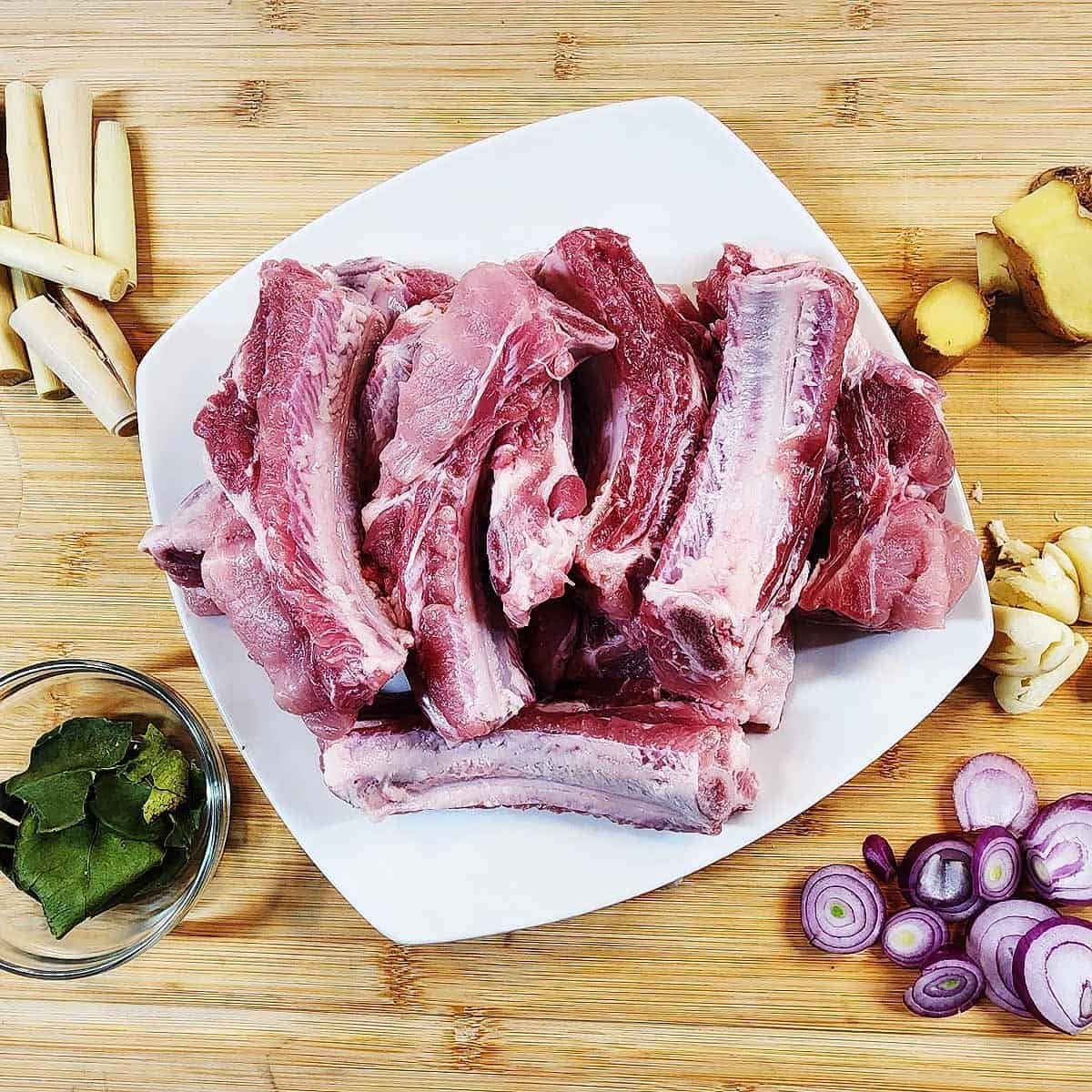
Blanch the pork ribs properly. In a large pot, bring water to a boil, then add the pork ribs and boil for 5 minutes—you'll see a grayish foam forming. This step removes impurities that would cloud your broth. After testing this recipe multiple times, I found that rinsing the ribs under cold water after blanching creates a clearer broth with cleaner flavors.
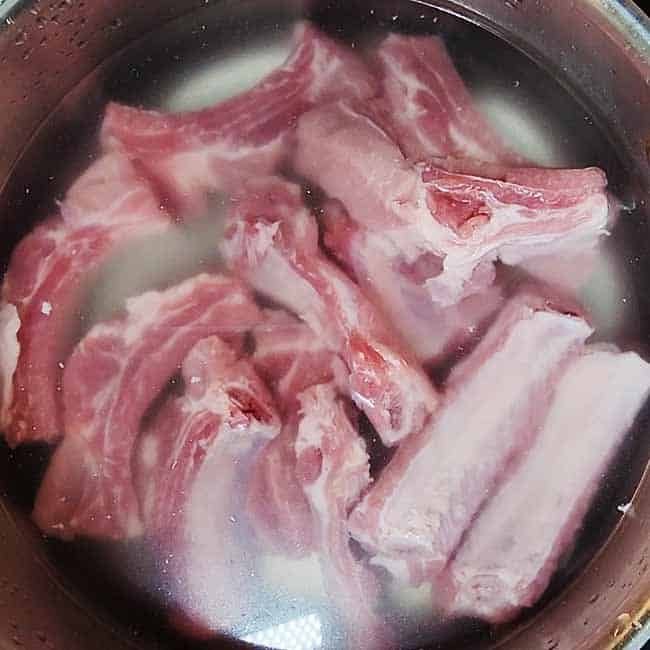
Test for perfect rib tenderness. Continue simmering until the meat shows slight resistance when pulled but separates easily—around 1.5 hours total. In version 3, I discovered perfect doneness occurs when you can pull the meat with chopsticks with just slight resistance. Patience transforms ordinary ribs into melt-in-your-mouth morsels with that distinctive family recipe texture.
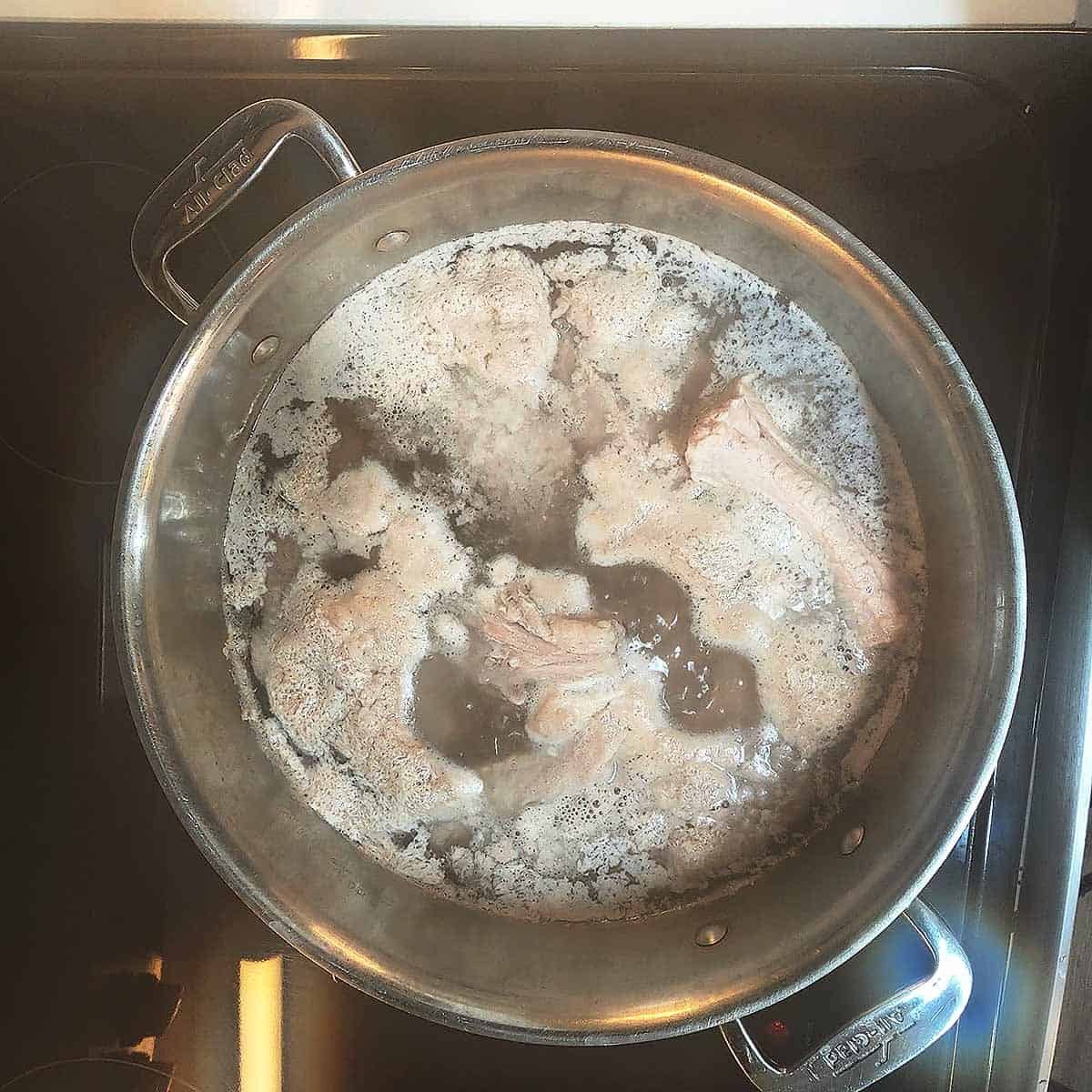
Balance the critical flavors. Add mushrooms and simmer for 10 minutes. Now comes the crucial stage—carefully add fish sauce first, then lime juice. I typically use more lime juice than most recipes (about 1 tablespoon per 4 cups of broth) based on feedback from my Thai Cooking Workshop students. Taste and adjust until you get that perfect sour-salty balance.
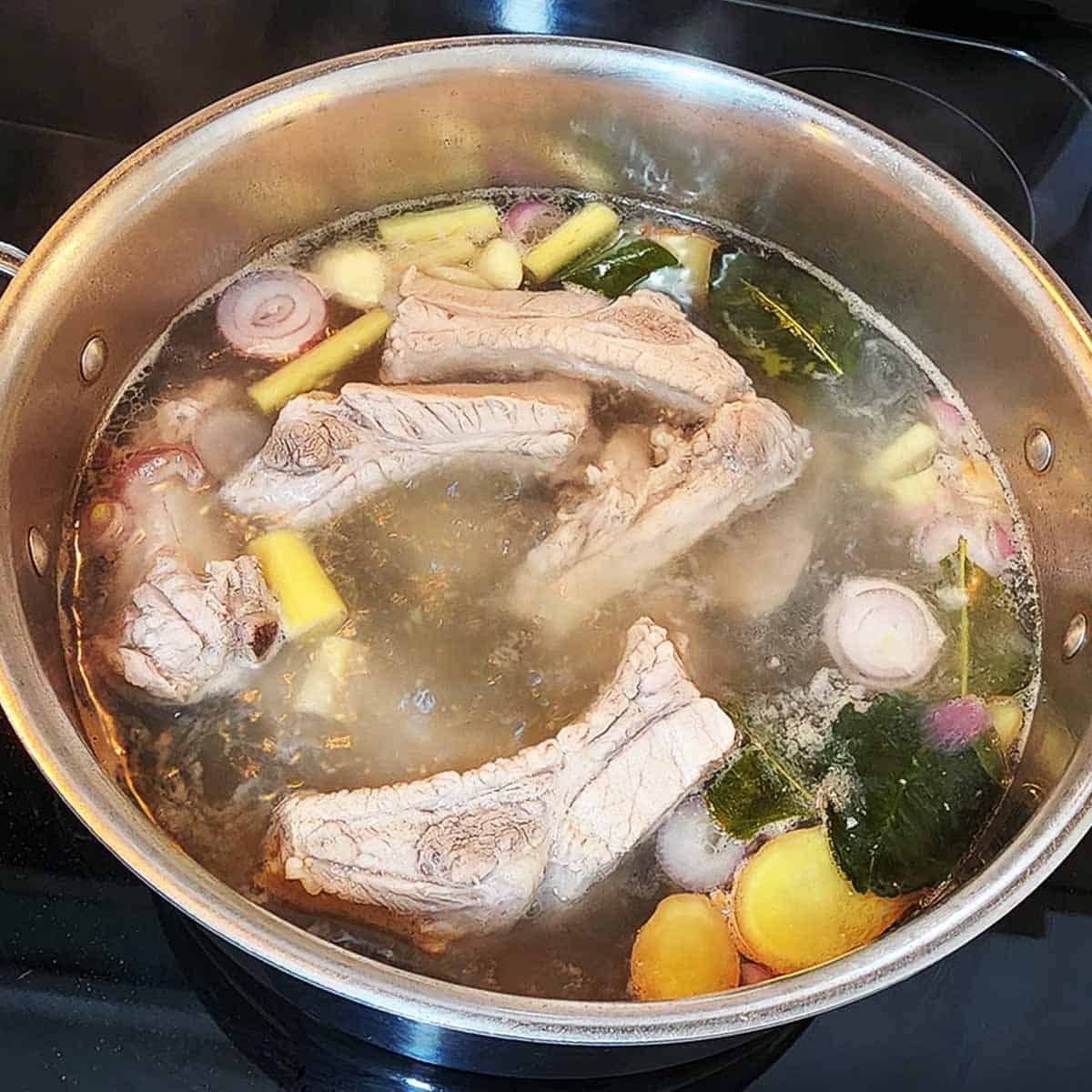
Finish with fresh elements. Ladle the hot soup into bowls, ensuring each serving gets ribs and mushrooms. Garnish with fresh cilantro, green onions, and chilies. The aromatics should rise visibly with the steam—a sign you've created authentic Tom Saap recipe. My grandmother said the first inhalation should make your eyes widen from the complex aroma profile.
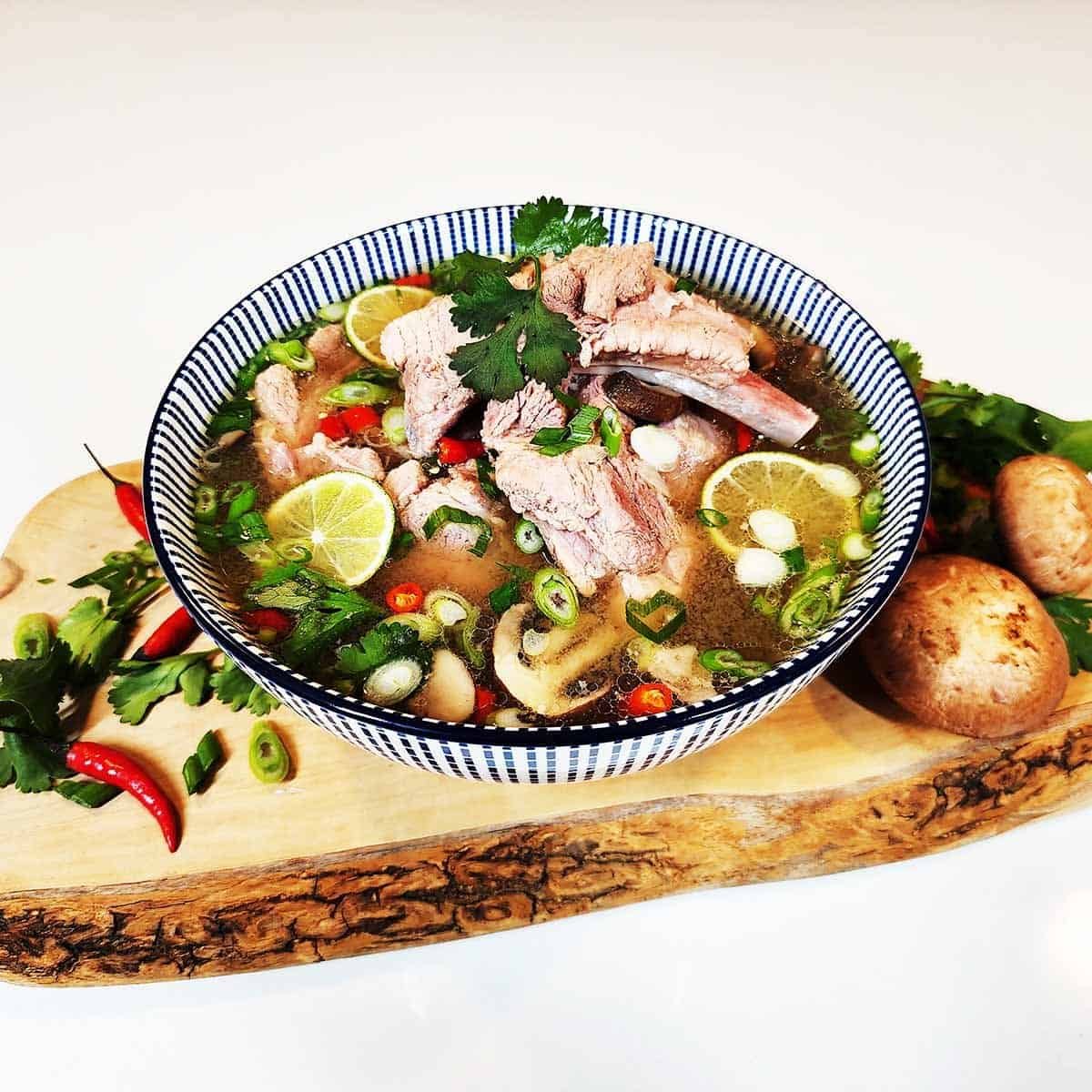
COMMON MISTAKES TO AVOID
Don't skip the blanching step for the pork ribs—this crucial technique removes impurities that would cloud your broth. I've found that many home cooks rush the simmering time, but patience here transforms tough ribs into melt-in-your-mouth meat. Adding lime juice too early will cause it to lose its bright flavor during long simmering; always add it at the final stage. Lastly, resist the urge to substitute ginger for galangal—they have completely different flavor profiles that will significantly alter the authentic taste.
TOM SAAP FLAVOR PROFILE AND PAIRING SUGGESTIONS
This Tom Saap recipe delivers a complex symphony of flavors that evolve as you eat. The first sensation is the aromatic fragrance of the herbs, followed immediately by a bright sourness that awakens your palate. This gives way to a deep umami richness from the pork, balanced by moderate spice heat that builds gradually rather than overwhelming.
The flavor elements include:
- Sour - From fresh lime juice and subtle fermented notes
- Spicy - Provided by fresh bird's eye chilies with their distinctive sharp heat
- Aromatic - Complex herbal notes from lemongrass, galangal, and kaffir lime leaves
- Savory - Umami depth from fish sauce and slow-simmered pork
This soup pairs beautifully with sticky rice, which consequently provides a neutral canvas to soak up the flavorful broth. For a complete Thai meal, therefore, serve alongside Som Tam (green papaya salad) for textural contrast and additionally include Gai Yang (grilled chicken) for a protein variation. As a result, the combination creates an authentic Isan experience. As for beverages, furthermore, ice-cold Thai beer or alternatively a simple cucumber-lime infused water perfectly complements the spicy-sour profile.
If you enjoy this recipe, please consider leaving a rating below!
RECIPE NOTES AND TIPS FOR PORK RIB SOUP
When testing version 4 of this recipe, I discovered a helpful technique. Preparing the aromatics the night before intensifies their flavors as they rest—something my mother from Korat always did. For an authentic touch, use a clay pot for serving. The slight porosity affects flavor development in a way that metal or glass can't match.
The original recipe from my grandmother's village used pork neck bones, which you can substitute for even deeper flavor, though they require 30 minutes additional simmering time. If you can't find fresh kaffir lime leaves, dried ones work adequately—just double the quantity and crush them slightly before adding. When using my Thai Pork Enamel pot (the same style my family has used for generations), I've noticed the temperature regulation helps prevent the broth from reducing too quickly.
I'd love to hear how this recipe turned out for you in the comments below!
FREQUENTLY ASKED QUESTIONS
What can I substitute for galangal in Tom Saap?
While nothing truly replicates galangal's unique citrusy-pine flavor, fresh ginger can work in a pinch. Use ¾ the amount called for and add an extra kaffir lime leaf to help compensate for the missing floral notes. The finished soup will have a different but still delicious flavor profile.
Is Tom Saap difficult to make for beginners?
Tom Saap is actually quite approachable for beginners! The techniques are straightforward—primarily simmering and seasoning. The most critical skills are balancing the sour-salty flavors at the end and having patience during the simmering stage to ensure tender meat.
How can I store leftover Tom Saap?
Store leftover soup in an airtight container in the refrigerator for up to 3 days. The flavor actually improves overnight as the aromatics continue to infuse the broth. Reheat gently on the stovetop until just simmering to preserve the bright flavors.
What's the difference between Tom Saap and Tom Yum?
Tom Saap originates from Isan (northeastern Thailand) and uses pork ribs as its base with a more pronounced sour flavor. In contrast, Tom Yum is a central Thai soup, typically made with shrimp (Tom Yum Goong), and often includes coconut milk in creamy versions. The broth in Tom Saap is generally clearer and more intense than its central Thai counterpart.
Can I make Tom Saap vegetarian?
Yes! Substitute the pork ribs with meaty mushrooms like king oyster or shiitake, and use salt or soy sauce instead of fish sauce. The key is maintaining the aromatic base and sour-spicy balance. I've found that adding a tablespoon of white miso paste helps create the depth typically provided by the pork.
Sign up for my newsletter to receive more authentic Thai recipes directly to your inbox!
MORE THAI RECIPES YOU'LL LOVE
f you enjoyed this Tom Saap, try my family's Gaeng Om recipe. It's another northeastern Thai specialty with similar herbs but creates a thicker, more fragrant broth. My Authentic Tom Kha Gai uses the same aromatic base. The difference? It adds coconut milk for a creamy texture. For another pork option, explore my Khua Kling. This dry-fried pork dish with southern Thai spices pairs beautifully with Tom Saap. The Naam Prik Noom (northern Thai green chili dip) makes an excellent soup accompaniment. Need a quick weeknight option? My Authentic Pad Krapow offers similar aromatics in a stir-fry form.
Don't forget to tag @SusieCooksThai in your social media posts when you make this recipe!






Leave a Reply